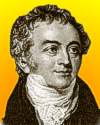
On 13 Jun 1773, English physician, physicist and Egyptologist was born. If you've taken a physics class, his name probably came up, though without much fanfare.
And yet he has been called one of the greatest minds since Isaac Newton. His breadth of knowledge was almost all-encompassing. In fact, it was said that if he learned something about law, he'd know a little about everything!
Even if you know his name, you probably did not know he started as a physician (M.D.). The biography of Thomas Young from Harper's Magazine (1890) reveals a fascinating man, and is another example of an article you read—and then come away wondering how you could have known so little before about a scientist who had made such significant contributions.
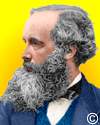
On 13 Jun 1831, James Clerk Maxwell, a Scottish physicist was born. His name is so well-known you, because he is one of the giants in his work on electromagnetic fields. Maxwell bridged the gap between Newton and Einstein. Today's book pick is: , by , who writes a biography of this remarkable scientist, known for approaching science with a freshness unbound by convention or previous expectations. He produced some of the most original scientific thinking of the nineteenth century — and his discoveries went on to shape the twentieth century.
It is available from Amazon, typically about (As of earlier time of writing - subject to change.)
 | All the mathematical sciences are founded on relations between physical laws and laws of numbers, so that the aim of exact science is to reduce the problems of nature to the determination of quantities by operations with numbers. |
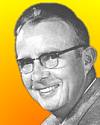 | All the good experimental physicists I have known have had an intense curiosity that no Keep Out sign could mute. |
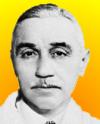 | The study of the serum of immunized animals forms a new chapter in the history of the struggle between the animal and infective agents, under which heading practical results of the highest importance are already inscribed. Any explanation of the phenomena is, however, still far from complete. |
| Before you look at today's web page, see if you can answer some of these questions about the events that happened on this day. Some of the names are very familiar. Others will likely stump you. Tickle your curiosity with these questions, then check your answers on today's web page. | |
| Births | |
 | James Clerk Maxwell, a Scottish physicist and mathematician, was born on 13 Jun 1831. His researches united electricity and magnetism into the concept of the electro-magnetic field. The four partial differential equations, now known by his name, first appeared in fully developed form in Electricity and Magnetism (1873). On what evidence did he proposed that the phenomenon of light is an electromagnetic phenomenon? |
 | Thomas Young, English physician, physicist and Egyptologist, was born 13 Jun 1773. His study of the interference of light reinforced the wave theory of light. A modulus of elasticity is named after his work with elasticity. Which Egyptian hieroglyphs did Young help decipher? |
| Deaths | |
 | James B. Pollack died 13 Jun 1994. He was a NASA researcher, who helped develop the theory that atomic war would result in a “nuclear winter.” He modelled the early evolution of the giant gas planets. He discovered the first real evidence that the clouds of Venus are composed of acid. Which acid did he find in the clouds of Venus? |
 | Freidrich Earnst Dorn (1848-1916) was a German physicist who followed Madame Curie's discoveries with his own study of radioactivity and discovered that radium not only emitted radiation, but released a gas that was also itself radioactive. The experiment provided the first clearly demonstrated example of one element transmuting to another through the process of releasing radiation. What radioactive gaseous element did he discover? |
| Events | |
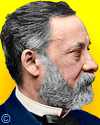 | In 1877, Louis Pasteur began his quest to develop a vaccine for a certain disease by visiting the slaughterhouses of Chartres to take blood samples from corpses of farm animals that had died of this disease. For what disease did he seek to prepare a vaccine? |
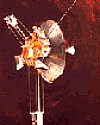 | In 1983, space probe vehicle Pioneer 10 crossed the orbit of a ceratin planet, a landmark event in its travel across the Solar System. Which planet orbit did it cross, and why was it a landmark event? |
Fast answers for the previous newsletter for June 12: radio waves • John Augustus Roebling • bees • the study of rock minerals by viewing thin slices of rock under a microscope • Gossamer Albatross • the walking gait of individuals, to distinguish between actual and spurious limps in damage claims for injuries • the decade including the year 1913.
 If you enjoy this newsletter, the website, or wish to offer encouragement or ideas, please send feedback by using your mail reader Reply button.
If you enjoy this newsletter, the website, or wish to offer encouragement or ideas, please send feedback by using your mail reader Reply button. Your click on a Facebook, StumbleUpon, or other social button on the site webpages is also a welcome sign of appreciation. Thank you for using them.
© This newsletter is copyright 2020 by todayinsci.com. Please respect the Webmaster's wishes and do not put copies online of the Newsletter — or any Today in Science History webpage. (If you already have done so, please remove them. Thank you.) Offline use in education is encouraged such as a printout on a bulletin board, or projected for classroom viewing. Online, descriptive links to our pages are welcomed, as these will provide a reader with the most recent revisions, additions and/or corrections of a webpage. For any other copyright questions, please contact the Webmaster by using your mail reader Reply button.
--
If you do not want to receive any more newsletters, Unsubscribe
To update your preferences and to unsubscribe visit this link
Executive Real Estate Business Class
-
"It was like a man with wings. It wasn't like anything you'd see on TV or in a monster movie." ...
About the publisher
Search This Blog
Blog Archive
-
▼
2021
(585)
-
▼
June
(64)
- On This Day for June 30 - Night of the Long Knives...
- Newsletter for Wednesday 30 June.
- On This Day for June 29 - London's Globe Theatre d...
- Newsletter for Tuesday 29 June.
- On This Day for June 28 - Assassination of Archduk...
- Newsletter for Monday 28 June.
- On This Day for June 27 - Yen made official moneta...
- Newsletter for Sunday 27 June.
- On This Day for June 26 - Opening of CN Tower, Bab...
- Newsletter for Saturday 26 June.
- On This Day for June 25 - Korean War begun, Antoni...
- Newsletter for Friday 25 June.
- On This Day for June 24 - Russia invaded by Napole...
- Newsletter for Thursday 24 June.
- On This Day for June 23 - Battle of Bannockburn, C...
- Newsletter for Wednesday 23 June.
- On This Day for June 22 - Mutiny against Henry Hud...
- Newsletter for Tuesday 22 June.
- On This Day for June 21 - Japanese forces defeated...
- Newsletter for Monday 21 June.
- On This Day for June 20 - Casket Letters found, Ho...
- Newsletter for Sunday 20 June.
- Tonight at 8/7c: Watch ‘Fight the Power’
- On This Day for June 19 - Rosenbergs executed for ...
- Newsletter for Saturday 19 June.
- On This Day for June 18 - War of 1812 begun, Sir P...
- Newsletter for Friday 18 June.
- On This Day for June 17 - Arrest of O.J. Simpson, ...
- Newsletter for Thursday 17 June.
- On This Day for June 16 - First woman in space, Jo...
- Newsletter for Wednesday 16 June.
- On This Day for June 15 - Magna Carta sealed by Ki...
- Newsletter for Tuesday 15 June.
- On This Day for June 14 - First prisoners at Ausch...
- Newsletter for Monday 14 June.
- On This Day for June 13 - Historic meeting between...
- Newsletter for Sunday 13 June.
- On This Day for June 12 - Election of Boris Yeltsi...
- Newsletter for Saturday 12 June.
- Listen Now! Blindspot: Tulsa Burning Podcast
- On This Day for June 11 - Oklahoma City bomber exe...
- Newsletter for Friday 11 June.
- On This Day for June 10 - First “witch” hanged in ...
- Newsletter for Thursday 10 June.
- On This Day for June 9 - Landslide reelection vict...
- Newsletter for Wednesday 9 June.
- On This Day for June 8 - Michelangelo's David inst...
- Newsletter for Tuesday 8 June.
- Action required: Update your HistoryExtra password
- On This Day for June 7 - Lateran Treaty ratified, ...
- Newsletter for Monday 7 June.
- On This Day for June 6 - Normandy Invasion begun, ...
- Newsletter for Sunday 6 June.
- On This Day for June 5 - Start of the Six-Day War,...
- Newsletter for Saturday 5 June.
- On This Day for June 4 - Dunkirk evacuation ended,...
- Newsletter for Friday 4 June.
- Tonight: ‘Alone’ Returns at 9:30/8:30c
- On This Day for June 3 - Pro-democracy protest in ...
- Newsletter for Thursday 3 June.
- On This Day for June 2 - Elizabeth II crowned quee...
- Newsletter for Wednesday 2 June.
- On This Day for June 1 - Debut of CNN, Morgan Free...
- Newsletter for Tuesday 1 June.
-
▼
June
(64)
-
Blogroll
-
About
HistoryFact










0 comments:
Post a Comment